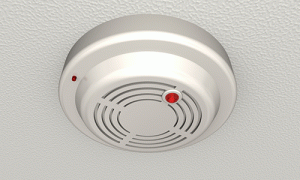 Carbon monoxide detectors are always on guard against the presence of the dangerous gas, and it’s important to check your detectors regularly to make sure they’re operating properly. Carbon monoxide (CO) is the most common cause of poisoning deaths in the developed world, so don’t take chances when it comes to CO safety in your home.
Carbon monoxide detectors are always on guard against the presence of the dangerous gas, and it’s important to check your detectors regularly to make sure they’re operating properly. Carbon monoxide (CO) is the most common cause of poisoning deaths in the developed world, so don’t take chances when it comes to CO safety in your home.
Carbon monoxide gas is produced by fuel combustion. Malfunctioning or improperly-vented gas-fired stoves, furnaces and water heaters are all potential indoor sources of this invisible, odorless gas. Carbon monoxide detectors measure not only the level of carbon monoxide in the air, but also duration of exposure. When both factors exceed safe limits, the unit sounds a piercing alarm to alert residents.
To function reliably, carbon monoxide detectors require two critical maintenance procedures:
Test the Detector
This monthly testing procedure is standard for most models, but check your owner’s manual to make sure.
- Press the “test” button on the front of the detector and hold it down for several seconds until you hear the alarm. Release the button when the alarm sounds.
- If the alarm fails to sound, verify that the unit is plugged into a wall outlet if it is an AC-powered detector. Replace the batteries if it’s a DC unit.
- Test again. Still no alarm? Replace the detector.
Replace the Batteries
Twice a year, install new batteries in a DC-powered detector. A detector that emits an intermittent chirp alarm may also require new backup batteries, which are utilized in the event of a household power failure.
Contact the experts at Ace Hardware Home Services for more information about installing carbon monoxide detectors in your residence.
Our goal is to help educate our customers in Dayton, Ohio about energy and home comfort issues (specific to HVAC systems).
Credit/Copyright Attribution: “TerryM/Shutterstock”







